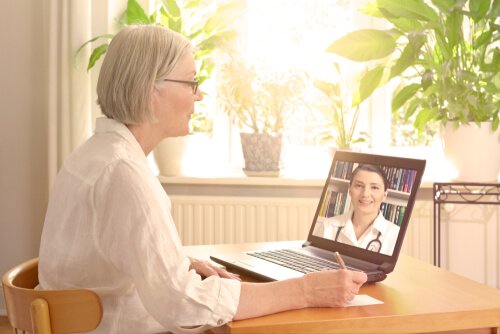Telemedicine during Lockdown

Currently, the coronavirus pandemic is posing a major challenge to society, particularly to the area of health. Due to the home confinement, the procedures we were used to are often not possible and we have to look for new alternatives. One of them is telemedicine. Find out all about telemedicine during lockdown in this article!
Although it isn’t a new practice, many people don’t know how it can help them and whether it’s a good or bad thing. That’s why, today, we’re going to explain what telemedicine during lockdown really consists of, along with its benefits and drawbacks.

What’s telemedicine?
Telemedicine, as its name suggests, is medical care at a distance. As we already mentioned, it isn’t a new thing. In fact, it’s been around for many years. It emerged in the 1970s, with the development of new technologies.
Its goal is to provide the necessary health care to patients without the need for them to travel to a health center. This has special benefits, in particular, for those who are immobilized or who have a hard time getting to a clinic.
Telemedicine often makes use of the telephone, as it’s the simplest, most accessible, and most inexpensive tool for the general population. Other options are, for example, video calls over the Internet. The particular benefit of the latter is that doctors are able to see the patient and make a physical evaluation. However, these aren’t always possible.
The advantages of telemedicine during lockdown
Telemedicine has many advantages that make it a useful and effective tool these days. Among them, we can highlight the following:
- It allows communication between the patient and a doctor 24 hours a day, 7 days a week.
- You can have on-demand appointments in the same way as conventional healthcare with face-to-face consultations.
- It opens up the possibilities of medical care for patients that have difficulty traveling.
- It facilitates quicker diagnosis and the prescribing of treatment.
- Doctors can continuously monitor a patient’s condition, especially chronic diseases.
- It makes it possible for health professionals to carry out health education, especially in the area of prevention.
- It minimizes exposure to infectious agents, which means protection for both the patient and the doctor.
- A reduction in costs.
- It facilitates the reduction of waiting lists to make more time for specialist consultations.
One of the important functions that telemedicine during lockdown can carry out is to classify patients according to their severity. In other words, to decide which patients really need emergency services.
At the same time, it guarantees attention for the milder cases, without the need for them to go to a health center. Most of the time, these patients only need advice and instructions to give them peace of mind to cope with their situation.

The disadvantages of telemedicine
However, telemedicine also has its disadvantages. The truth of the matter is that, even though it has many advantages, it also has major drawbacks. Among them are the following:
- A lack of privacy between the doctor and the patient, since the patient is usually surrounded by family members and/or caregivers.
- The harder it is for more disadvantaged groups of the population to access technology.
- Computer failures, slowness in the system, etc.
- The health centers needing to used adapted technologies.
- The impossibility of physically evaluating the patient. For example, to be able to assess respiratory conditions.
Another potential disadvantage of telemedicine is the way it can affect patients. It’s true that it’s a great advance for many, for others, it can become a source of anxiety. Health is a delicate subject and the way of dealing with it changes from one person to another.
The fact that the doctor isn’t physically with a person during the consultation, and that they can’t physically check us out are examples of situations that can cause anxiety and concern for patients. This could well be the case with the elderly who, in many cases, aren’t comfortable with new technology.
Although telemedicine isn’t new, the current coronavirus pandemic has turned it into a commonly-used tool for much of the population. Telemedicine has been a challenge for today’s society and is advancing by leaps and bounds.
This text is provided for informational purposes only and does not replace consultation with a professional. If in doubt, consult your specialist.








